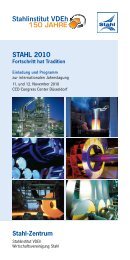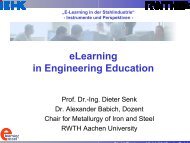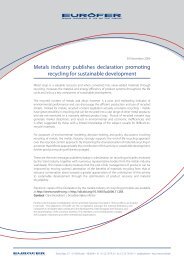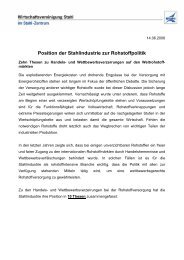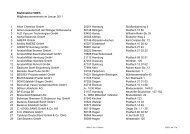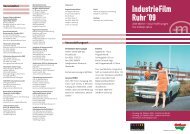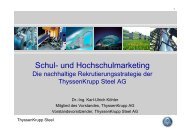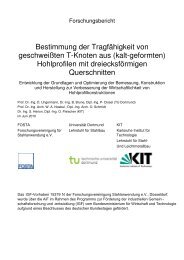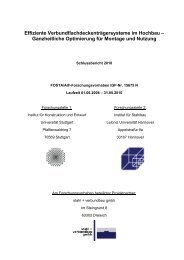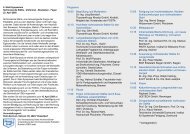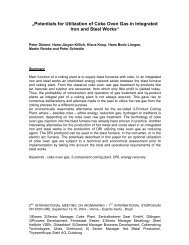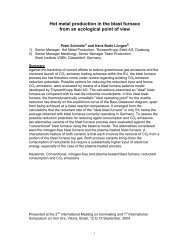brochure
brochure
brochure
You also want an ePaper? Increase the reach of your titles
YUMPU automatically turns print PDFs into web optimized ePapers that Google loves.
2008
Imprint<br />
Stahl-Zentrum<br />
Sohnstraße 65 • 40237 Düsseldorf • Germany<br />
Phone +49 (0) 211 6707 -0 • Fax +49 (0) 211 6707-676<br />
www.stahl-online.de • info@stahl-zentrum.de<br />
Editor: Public Relations, Stahl-Zentrum<br />
Layout, typesetting: etcetera Werbeagentur, Aachen<br />
Photos: AG der Dillinger Hütte, ArcelorMittal, Benteler Stahl, Feralpi, Georgsmarienhütte,<br />
HKM, Lech Stahlwerke, Riva Stahl, Saarstahl, Salzgitter, Stahl-Zentrum, Thüringer Stahlwerke,<br />
ThyssenKrupp, V & M Deutschland<br />
Copyright: German Steel Federation, Düsseldorf, Steel Institute VDEh, September 2008<br />
2
Editorial<br />
Germany is the industrial core re-<br />
gion in Europe. Its industries are<br />
based on effi cient and innovative<br />
materials and, in particular, a strong<br />
steel industry.<br />
The steel industry in Germany com-<br />
prises 100 companies and 91,000<br />
employees. All these companies in<br />
the steel industry are innovative and<br />
internationally active, with qualifi ed<br />
and highly motivated employees.<br />
Germany is also a centre of steel<br />
research and development, and<br />
the steel companies have achieved<br />
great successes here. The close<br />
connections between the steel in-<br />
dustry and its customers are also<br />
advantageous.<br />
Steel production in Germany fol-<br />
lows the principle of sustainability<br />
and is globally competitive. For its<br />
success the steel industry supports<br />
open markets and international fair<br />
trade rules.<br />
In this <strong>brochure</strong> you will find the<br />
most important facts and figures<br />
about the steel industry.<br />
Best wishes<br />
Hans Jürgen Kerkhoff<br />
President<br />
German Steel Federation<br />
Chairman<br />
Steel Institute VDEh<br />
3
The European Union – 27 member states<br />
The European Union is the world’s largest economic area. Germany is at the<br />
heart of Europe, particularly since the European Union’s enlargement, and<br />
was one of the founders of a united Europe. Germany and France, together<br />
with Belgium, Italy, the Netherlands and Luxemburg, were the fi rst mem-<br />
bers of the European Coal and Steel Community (ECSC) in 1952. The ECSC<br />
treaty expired in 2002. The EU 27 of 2007 has 485 million inhabitants and<br />
produces 210 million tonnes of crude steel. This is equivalent to 433 kg<br />
of steel per capita.<br />
4
The most important steel regions of the world<br />
The European Union’s steel industry – with a production of 210.3 million<br />
tonnes of crude steel in 2007 – makes it by far the world’s most important<br />
steel region after China. The EU is followed by Japan, USA, Russia, India<br />
and South Korea. Germany, with a crude steel production of 48.6 million<br />
tonnes in 2007, is the largest steel producer within the 27 member states.<br />
It is the seventh largest worldwide. The German Steel Federation expects<br />
a crude steel production of about 48.5 million tonnes in 2008.<br />
5
Crude steel production of the EU 27 countries, 2007<br />
6<br />
Crude steel production in million t<br />
50<br />
40<br />
30<br />
20<br />
10<br />
0<br />
30.9<br />
%<br />
69.1<br />
%<br />
48.6<br />
31.5<br />
63.3<br />
19.3 19.0<br />
36.7<br />
38.7 14.3<br />
61.3<br />
77.9<br />
22.1<br />
21.2 10.7 10.6 9.3 2.2 9.4<br />
33.2 7.6 7.4 7.0<br />
7.7<br />
41.7<br />
6.3 29.7<br />
5.7 5.1<br />
22.4 46.2<br />
78.8<br />
30.4 4.4<br />
33.9 2.9<br />
66.8 58.3<br />
2.6<br />
90.7<br />
2.2 1.9<br />
97.8 90.6 69.6 66.1 92.3 70.3 100 100 77.6 53.8<br />
D I F E GB B PL A NL CZ RO S SK FIN L GR H BG<br />
Stahl-Zentrum<br />
EU 27 Countries 2007: 209.5 million t<br />
Electric steel (40.2%)<br />
Oxygen steel (59.6%)<br />
OHF steel (0.3%)<br />
The extent to which the electric<br />
steel process is used varies greatly<br />
in the member states of the Euro-<br />
pean Union. While in Germany, the<br />
largest steel-producing nation,<br />
31 per cent is produced in electric<br />
arc furnaces, the share is consid-<br />
Source: IISI<br />
erably higher in Italy, Spain and<br />
Luxembourg. In the European<br />
Union of 27, 40 per cent is pro-<br />
duced in electric arc furnaces, i.e.<br />
largely on the basis of steel scrap.<br />
Thus a total of about 105 million<br />
tonnes of steel scrap is recycled.
The steel industry in Germany:<br />
production and sites<br />
Germany’s largest steel company<br />
is ThyssenKrupp which produced<br />
15.9 million tonnes of crude steel in<br />
2007 (including Hüttenwerke Krupp<br />
Mannesmann’s contribution).<br />
The world market leader Arcelor-<br />
Mittal was in second place in 2007<br />
with a production of 8.0 million<br />
tonnes at its German sites in Bre-<br />
men, Duisburg, Eisenhüttenstadt<br />
and Hamburg.<br />
It is followed by Salzgitter AG with<br />
its sites Salzgitter and Peine in the<br />
middle of Germany.<br />
7
Crude steel production in Germany<br />
8<br />
Hamburg (1)<br />
Lingen (3)<br />
Bremen (2)<br />
Georgsmarienhütte<br />
(4)<br />
Hennigsdorf (7)<br />
Duisburg (9;10; 11)<br />
Bochum (12)<br />
Peine (5)<br />
Salzgitter (5)<br />
Brandenburg (6) Eisenhüttenstadt<br />
(8)<br />
Witten (13)<br />
Riesa (16)<br />
Krefeld<br />
(12) Konverter Siegen (13; 17)<br />
Freital (17)<br />
Gröditz (4)<br />
Trier (18)<br />
Wetzlar (14)<br />
Unterwellenborn (15)<br />
Dillingen (19)<br />
Bous (4)<br />
Völklingen (20)<br />
Kehl (21) Herbertshofen (22)<br />
Electric steel works<br />
and rolling mill<br />
Integrated iron and steel works<br />
(Blast furnace, steel works and rolling mill)
The proportion of special steel production rose from 10.2 per cent in 1970<br />
to 20.0 per cent in 2007. Flat and one-third long products represented<br />
two-thirds of total rolled steel production in 2007, whereby the share of<br />
fl at products has risen considerably since 1970.<br />
Production Production in in million<br />
million t<br />
50<br />
40<br />
30<br />
20<br />
10<br />
Basic<br />
Bessemer<br />
steel<br />
Crude steel Rolled steel total<br />
High-grade steel Long products<br />
45.0<br />
Electric steel<br />
1970 - 1990 Western Germany<br />
43.8<br />
38.4<br />
OH 34.0<br />
35.8<br />
steel 30.5 30.8<br />
LD<br />
steel<br />
4.6<br />
10.2%<br />
17.6<br />
57.7%<br />
12.9<br />
42.3%<br />
5.8<br />
13.2%<br />
20.1<br />
65.3%<br />
10.7<br />
34.7%<br />
5.7<br />
14.8%<br />
34.7<br />
29.7<br />
21.3<br />
71.7%<br />
8.4<br />
28.3%<br />
Flat products<br />
48.6<br />
46.4<br />
42.0<br />
9.9<br />
20.0%<br />
1970 1980 1990 2007<br />
27.7<br />
66.0%<br />
14.3<br />
34.0%<br />
Source: The steel industry’s statistical yearbook, Stahl-Zentrum<br />
9
Employees, sales and productivity<br />
in Germany: 1960-2007<br />
Sales, and above all, productivity (calculated in tonnes per employee), of<br />
the steel companies in Germany have consistently risen since the 1960s.<br />
The companies have successfully completed the restructuring and privati-<br />
sation process. The European steel industry is one of the pioneers of this<br />
development. As a result, the steel companies in Germany are among the<br />
most competitive worldwide.<br />
417<br />
10<br />
374<br />
Employees*<br />
(in 1,000)<br />
288<br />
175<br />
103 92.4<br />
'60 '70 '80 '90 '00 '07<br />
25.2<br />
25.9<br />
Total turnover**<br />
(in billion EUR)<br />
Foreign<br />
37 %<br />
25.9<br />
26.3<br />
2007<br />
Domestic<br />
63 %<br />
32.3<br />
37.2<br />
41.7<br />
'00 '01 '02 '03 '04 '05 '06<br />
82<br />
Productivity<br />
(tonnes per employee)<br />
102<br />
152<br />
220<br />
452<br />
526<br />
'60 '70 '80 '90 '00 '07<br />
* At the end of the year in the steel industry, including associated operations<br />
** Federal Statistics Office: production of pig iron, steel and ferroalloys and<br />
production of steel pipe and pipe pieces made of steel<br />
48.8<br />
'07
Raw material<br />
Germany has no metallic raw materials. The steel industry in Germany<br />
is therefore – with the exception of steel scrap – 100 per cent dependent<br />
on imports.<br />
Around two tonnes of raw materials are needed for every tonne of steel.<br />
At 44.4 million tonnes, iron ore accounts for the largest quantity in 2007.<br />
Imports come above all from Brazil, Canada and Sweden. The second<br />
important raw material is steel scrap at 21.7 million tonnes. Coal is mainly<br />
imported, chiefl y from Australia, the USA and Canada.<br />
11
Crude steel production by process<br />
The majority of the crude steel made in Germany (about 69 per cent) is<br />
produced by the basic oxygen process, the remainder is made in electric<br />
arc furnaces. A full 97 per cent of the crude steel output comes via the<br />
modern continuous casting process, compared to an average of 90 per<br />
cent worldwide.<br />
Production in million t<br />
12<br />
60<br />
50<br />
40<br />
Total Crude crude steel<br />
production<br />
steel<br />
Share of continuous<br />
casting<br />
100<br />
30<br />
20<br />
10<br />
0<br />
50<br />
Open hearth<br />
steel<br />
Thomas steel<br />
55 60 65 70 75 80<br />
Oxygen steel 69.1 %<br />
Ox��en<br />
steel<br />
30.9 %<br />
Electric steel<br />
85 90 95 2000 05<br />
50<br />
40<br />
30<br />
20<br />
10<br />
0<br />
Year<br />
Source: IISI<br />
90<br />
80<br />
70<br />
60<br />
Share of continuous casting in %
Germany‘s blast furnaces are in the top league<br />
Reducing agents consumption<br />
in kg/t HM<br />
800<br />
760<br />
750<br />
700<br />
Figures of 2007<br />
650<br />
600<br />
550<br />
500<br />
450<br />
400<br />
350<br />
300<br />
250<br />
200<br />
604<br />
587<br />
552 544 540<br />
510 508 497 493 492 488<br />
475<br />
559<br />
India<br />
Ukraine<br />
China<br />
The steel companies in Germany<br />
have always been particularly in-<br />
novative and are under the tech-<br />
nological leaders worldwide. These<br />
reductions have been achieved with<br />
effi cient heat and energy recovery<br />
systems and other innovations in<br />
the production process. Thus Ger-<br />
Russia<br />
Other<br />
Europe<br />
Africa, Middle<br />
East, Oceania<br />
NAFTA<br />
man blast furnaces – with 488 kg<br />
per tonne of hot metal – have a<br />
considerably lower consumption of<br />
reducing agents than most regions<br />
and countries worldwide. The global<br />
average is 559 kg per tonne of hot<br />
metal.<br />
Taiwan<br />
Japan<br />
EU 15<br />
South<br />
Korea<br />
Germany<br />
South<br />
America<br />
World<br />
Ga s<br />
Oil<br />
Coal<br />
Coke<br />
Source: Stahl-Zentrum<br />
13
Commitment to<br />
sustainable development<br />
Sustainability and environment-<br />
friendly production have a high pri-<br />
ority for the German steel industry.<br />
21 sustainability indicators, whose<br />
development is summarised in a<br />
report each year, are defi ned in the<br />
“Guiding principle of sustainability<br />
– steel”, which was fi rst published<br />
in November 2001.<br />
Indicators of sustainable steel<br />
1. Economy<br />
• Steel production<br />
• Steel utilization<br />
• Profi tability<br />
• Trading<br />
• Productivity of work force<br />
• Expenditures for steel research<br />
14<br />
2. Raw material, energy and<br />
environmental effi ciency<br />
• Energy effi ciency<br />
• Iron effi ciency<br />
• Refractory effi ciency<br />
• CO 2 reduction<br />
• Scrap recycling<br />
• Slag production and utilization<br />
• Water utilization<br />
• Dust emission<br />
• Utilization of transport systems<br />
3. Human indicators<br />
• Accident frequency rate<br />
• Share of skilled workers<br />
• Share of engineers<br />
• Share of apprentices<br />
• Training days per employee<br />
• Ideas management<br />
Sustainable development begins<br />
before production with the delivery<br />
of the raw materials and continues<br />
after the end of the steel products’<br />
life cycle, because steel is a fully<br />
recyclable material. The steel in-<br />
dustry in Germany today consumes<br />
nearly 40 per cent less energy than<br />
in 1960. During the same period<br />
the industry has also cut water<br />
consumption and carbon dioxide<br />
emissions by half and dust emis-<br />
sions by a massive 90 per cent. The<br />
by-products of steel production are<br />
also used in different ways.
Energy effi ciency and CO 2 emissions<br />
Climate change is one of the world’s<br />
most important political tasks. The<br />
voluntary commitment of the steel<br />
industry in Germany for a 22 per<br />
cent reduction in CO 2 emissions by<br />
2012 is well on the way to success.<br />
Many industries in Europe have<br />
clearly given priority to voluntary<br />
Index CO2 reduction<br />
100<br />
95<br />
90<br />
85<br />
80<br />
The voluntary commitment of the Steel Industry in Germany<br />
to reduce CO2 emissions*)<br />
Base 1990<br />
Target<br />
Specific CO2 emissions of crude steel<br />
production with external power<br />
Specific CO2 emissions of crude<br />
steel production without external power<br />
75<br />
1990 1993 1995 1997 1999 2001 2003 2005<br />
*) includes all CO 2 emissions and emissions trade to the steel works<br />
agreements over regulatory gov-<br />
ernmental measures.<br />
Specifi c energy consumption in<br />
tonnes coal unit per tonne crude<br />
steel has been reduced from 1.0<br />
to 0.6 since 1960. Specifi c CO 2<br />
emissions have fallen from 2.4 to<br />
-15.8%<br />
-18.2%<br />
CO 2 =<br />
-22%<br />
2007 2009 2011 2013<br />
2012<br />
Source: Stahl-Zentrum<br />
Specific energy consumption<br />
in t coal unit/t crude steel<br />
1.3 tonnes per tonne of crude steel<br />
since 1960. These fi gures show<br />
that the steel companies in Ger-<br />
many have successfully increased<br />
their energy effi ciency and made<br />
a major contribution to the fi ght<br />
against climate change.<br />
1.1<br />
1.0<br />
0.9<br />
0.8<br />
0.7<br />
0.6<br />
0.5<br />
0.4<br />
0.3<br />
0.2<br />
0.1<br />
0<br />
1960 70 80 90 2000<br />
Source: Stahl-Zentrum<br />
3.0<br />
2.8<br />
2.6<br />
2.4<br />
2.2<br />
2.0<br />
1.8<br />
1.6<br />
1.4<br />
1.2<br />
1.0<br />
0.8<br />
Specific CO2 emissions in t/t crude steel<br />
15
Utilisation of slag as a by-product of steelmaking<br />
The total amount of slag generated<br />
during the production of one tonne<br />
of crude steel has been reduced<br />
from 380 kg per tonne to about<br />
310 kg per tonne. The use of the by-<br />
product slag leads to considerably<br />
better resource effi ciency. A total of<br />
about 15 million tonnes of slag was<br />
produced in 2006. Of this, most is<br />
exploited as building material or as<br />
granulated blast-furnace slag for<br />
cement production.<br />
In this way nearly 15 million tonnes<br />
less natural mineral material is re-<br />
moved from nature. At the same<br />
16<br />
time, about one tonne of CO 2 per<br />
tonne of cement clinker can be<br />
saved during cement production.<br />
Overall the aim is to produce no<br />
waste and reduce to zero the re-<br />
maining quantity dumped.
Environment-friendly<br />
steel production<br />
Cooling water is a very important<br />
natural resource<br />
During the last 20 years the specifi c<br />
water requirement in m 3 per tonne<br />
of crude steel has been reduced by<br />
more than two thirds. Only about<br />
10.6 m 3 water per tonne of crude<br />
steel is now required. Cooling water<br />
is managed in a circulatory system<br />
Dust emissions from iron and steel<br />
production in Germany<br />
The generation of dust in kg per<br />
tonne of crude steel has been re-<br />
duced from about 9.0 kg to well<br />
below 0.5 kg since 1960. This has<br />
substantially improved air quality.<br />
at all steelworks, and after its use<br />
it is returned to nature cleaner than<br />
when it was taken up.<br />
Specific dust emission<br />
in kg/t crude steel<br />
17
The steel industry’s innovations<br />
Germany’s steel industry is invest-<br />
ing in its future. Steel producers<br />
are maintaining their profi tability<br />
by continuous innovations in their<br />
steel production processes and by<br />
focusing on high-return products<br />
such as tailored blanks and tubes,<br />
and cold-rolled surface-finished<br />
strip and sheet, as well as by de-<br />
veloping new products that open<br />
new areas of application for steel.<br />
One example of the innovative ca-<br />
pability of German industry is the<br />
Steel Innovation Prize awarded<br />
every three years, for which there<br />
are about 650 entrants. Employee<br />
motivation is the basis for innova-<br />
tion and progress.<br />
18<br />
Process<br />
innovation<br />
Management<br />
innovation<br />
Material<br />
innovation<br />
Resource efficiency<br />
natural *), capital and<br />
human resources<br />
Application<br />
innovation<br />
Product<br />
innovation<br />
Manufacturing<br />
innovation<br />
*) Raw materials, energy, environment, climate Source: Stahl-Zentrum
Close co-operation with customers<br />
Steel plays a central role in the most<br />
important industrial value creation<br />
chains in Germany. German steel-<br />
makers work hand-in-hand with<br />
their customers to harmonise en-<br />
gineering requirements with mate-<br />
rial specifi cations, optimise manu-<br />
facturing technologies, and design<br />
products with tailored strengths<br />
and properties. Germany has more<br />
leading automotive companies than<br />
any other nation. Germany’s me-<br />
chanical engineering sector is the<br />
world champion in exports. More-<br />
over, the steel industry is closely<br />
meshed with the producers of metal<br />
goods, most of whom are small and<br />
medium-sized enterprises. These<br />
include the steel-forming compa-<br />
nies, the drawing plants and cold-<br />
rolling works. Maintenance and<br />
intensifi cation of the longstanding<br />
relationships between the steel<br />
companies and their development<br />
partners is helping to sustain Ger-<br />
many’s technological leadership,<br />
making a decisive contribution to<br />
customer loyalty and providing a<br />
solid foundation for the future of<br />
the industries in our country.<br />
Germany’s dense industrial struc-<br />
ture, particularly in the steel-inten-<br />
sive sectors, gives Germany consid-<br />
erable advantages as a location for<br />
companies. This not only involves<br />
logistics, but also an innovative lead<br />
brought about by close co-operation<br />
in research and development. Cus-<br />
tomers make ever-increasing de-<br />
mands on steel companies in order<br />
to be able to maintain their position<br />
in international competition as a<br />
result of prompt deliveries and high<br />
product quality. Together with their<br />
customers, the steel industry is in-<br />
creasingly working within a system<br />
partnership on material-oriented<br />
constructions and optimised pro-<br />
duction techniques.<br />
19
Organisations of the Stahl-Zentrum<br />
The organisations working under<br />
the aegis of the Stahl-Zentrum are<br />
service providers for steel compa-<br />
nies. They contribute towards con-<br />
solidating the interests of the steel<br />
industry, and ensuring that both the<br />
political institutions and the public<br />
pay suffi cient attention to the in-<br />
dustry. Moreover, the Stahl-Zentrum<br />
supports its member companies<br />
with a wide variety of activities and<br />
information. What characterises<br />
the steel organisations is not just<br />
their many years’ experience. Their<br />
expertise is also the result of a far-<br />
reaching network of differing areas<br />
of competence, as well as close col-<br />
laboration with the companies and<br />
their representatives.<br />
20<br />
Wirtschaftsvereinigung Stahl (The German Steel Federation), founded<br />
in 1874, is the political-economic association of the steel industry in<br />
Germany. It represents the branch-related political interests of almost all<br />
the companies producing steel in Germany, as well as associated foreign<br />
member companies, in politics, in business and to the public.<br />
Important websites of the Stahl-Zentrum www.stahl-online.de<br />
• Wirtschaftsvereinigung Stahl (WV): www.wvstahl.de<br />
• Edelstahl-Vereinigung e. V. (EV): www.stahl-zentrum.de<br />
• Delkrederestelle Stahl: www.stahl-zentrum.de<br />
• Stahl-Informations-Zentrum (S-I-Z): www.stahl-info.de<br />
• Informationsstelle Edelstahl Rostfrei (ISER): www.edelstahl-rostfrei.de<br />
• BAUEN MIT STAHL e. V. (BmS): www.bauen-mit-stahl.de
Service providers for<br />
steel companies<br />
The Stahlinstitut VDEh (The Steel<br />
Institute VDEh) was founded in 1860.<br />
The institute fosters technical-sci-<br />
entifi c co-operation between engi-<br />
neers for the further development<br />
of steel technology and the material<br />
steel through joint research and ex-<br />
changes of experience. The German<br />
steel technology network includes<br />
in addition to the Stahl-Zentrum and<br />
the steel companies’ research facili-<br />
ties and institutes for joint research<br />
various universities. The close col-<br />
laboration between steel producers<br />
and processors allows the direct<br />
implementation of material innova-<br />
tions in existing production chains.<br />
The joint work has since become<br />
internationally oriented.<br />
Important websites of the Stahl-Zentrum<br />
• VDEh: www.vdeh.de<br />
• FOSTA: www.stahlforschung.de<br />
• BFI: www.bfi .de<br />
• MPIE: www.mpie.de<br />
Metal goods<br />
industry<br />
(Technical) Universities (Selection)<br />
Aachen Bochum Braunschweig Clausthal Darmstadt Dortmund<br />
Duisburg Erlangen Freiberg Hannover München Stuttgart<br />
Research facilities in<br />
the steel companies:<br />
� Research Institutes<br />
� Centers for Steel Application<br />
Steel<br />
Institute<br />
VDEh<br />
and<br />
FOSTA<br />
Joint Research of the Steel Industry in Germany<br />
Steel users<br />
Automobile<br />
manufacture<br />
Steel<br />
Industry<br />
Mechanical<br />
engineering<br />
Institutes for joint research:<br />
� Max-Planck-Institute for Iron<br />
and Steel Research (MPIE)<br />
� Interdisciplinary Centre for<br />
Advanced Materials Simulation<br />
(ICAMS)<br />
� FEhS Building Materials<br />
Institute<br />
� Research Centre for Iron<br />
Ore Agglomeration (SGA)<br />
� VDEh-Institute for Applied<br />
Research<br />
BFI ®<br />
Steel<br />
construction<br />
Electrical<br />
engineering<br />
21
• Crude steel (2007): 2.7 million tonnes<br />
• Turnover (2007): € 2.6 billion<br />
•<br />
Employees (2007): 5,233<br />
AG der Dillinger Hüttenwerke<br />
22<br />
Dillinger Hütte is the global benchmark for heavy plates up to 410 mm<br />
thickness and 5.2 m width. In 2007 Dillinger Hütte registered the best<br />
year in its history with record levels in production and results (EBIT of 493<br />
million Euros). Dillinger Hütte contributes to major projects, among others<br />
in engineering, offshore, linepipe, pressure vessel, steel construction, e.g.<br />
Viaduc de Millau, Shanghai World Financial Center – one of the world’s tallest<br />
skyscrapers – and the Allianz Arena stadium in Munich.<br />
Werkstraße 1 • 66763 Dillingen<br />
Phone +49 (0) 6831 47-0<br />
www.dillinger.de • info@dillinger.biz
ArcelorMittal<br />
ArcelorMittal is the world‘s number one steel company, with 310,000 em-<br />
ployees in more than 60 countries.<br />
ArcelorMittal is the leader in all major global markets, including automo-<br />
tive, construction, household appliances and packaging. The Group leads in<br />
R&D and technology, holds sizeable captive supplies of raw materials and<br />
operates outstanding distribution and service networks.<br />
23
Its industrial presence in Europe,<br />
Asia, Africa and the Americas gives<br />
the Group exposure to all the key<br />
steel markets, from emerging to<br />
mature. ArcelorMittal generated<br />
revenues of USD 105.2 billion in<br />
2007, with a crude steel production<br />
of 116 million tonnes, representing<br />
around 10 per cent of world steel<br />
output.<br />
It continued to explore growth op-<br />
portunities in 2007, with 35 acquisi-<br />
24<br />
tion transactions that were agreed<br />
upon and identifying organic growth<br />
projects that will expand output by<br />
20 million tonnes by 2012.<br />
In Germany, ArcelorMittal is the<br />
second largest steel producer with<br />
an output of approximately 8 mil-<br />
lion tonnes this year. The company<br />
operates facilities for fl at products<br />
in Bremen and Eisenhüttenstadt<br />
and plants specializing in long prod-<br />
ucts in Duisburg and Hamburg. The<br />
four German sites employ approxi-<br />
mately 8,000 people. Additionally,<br />
ArcelorMittal also has a variety of<br />
sales operations in Germany and<br />
holds a 51 per cent stake in Dillinger<br />
Hütte.<br />
The most important market for the<br />
four local sites is Germany. For the<br />
three West-German facilities, the<br />
second largest market is the EU,<br />
whereas Eisenhüttenstadt with its<br />
favourable location at the Polish<br />
border ships 47 per cent of its prod-<br />
ucts to Central and Eastern Europe.<br />
The single largest customer group<br />
for the four German plants is the<br />
automotive industry, which accounts<br />
for approximately one third of ship-<br />
ments. Other key industries served<br />
include railway, household applianc-<br />
es, machinery and construction.<br />
19, avenue de la Liberté<br />
2930 Luxembourg<br />
Phone +352 4792-1<br />
www.arcelormittal.com<br />
contact@arcelormittal.com
• Crude steel production (2007): 3.3 million tonnes<br />
• Turnover (2007): € 1.78 billion<br />
•<br />
Employees (2007): 3,600<br />
ArcelorMittal<br />
Bremen GmbH<br />
Founded in 1957, ArcelorMittal Bremen is today a fully<br />
integrated and highly automated plant producing hot<br />
rolled, cold rolled and galvanized fl at carbon steel prod-<br />
ucts. The site comprises:<br />
• port facilities at the river Weser<br />
• sinter plant and two blast furnaces<br />
• two converters and a continuous caster<br />
• hot strip mill<br />
• pickling line<br />
• tandem mill<br />
• hot-dip galvanizing (and galvanealing) line<br />
• hot-dip galvanizing line (for full-hard, hot strip)<br />
Carl-Benz-Straße 30 • 28237 Bremen<br />
Phone +49 (0) 421 648-0<br />
• Crude steel production (2007): 2.3 million tonnes<br />
• Turnover (2007): € 1.3 billion<br />
• Employees (2007): 2,624<br />
ArcelorMittal<br />
Eisenhüttenstadt GmbH<br />
ArcelorMittal Eisenhüttenstadt was founded in 1950 and<br />
is located on the River Oder, right at the Polish border.<br />
This favourable location makes it a key supplier of hot<br />
rolled, cold rolled and galvanized fl at carbon steel prod-<br />
ucts for Central and Eastern Europe. The facility is a<br />
fully integrated and highly automated plant including:<br />
• sinter plant and two blast furnaces<br />
• two basic oxygen furnaces (BOFs)<br />
• two continuous casters for both slabs and blooms<br />
• a modern hot rolling mill with coil box<br />
• two high-performance cold rolling mills<br />
• two hot-dip galvanizing lines<br />
15888 Eisenhüttenstadt<br />
Phone +49 (0) 3364 37-0<br />
25
• Liquid steel production (2007): 950,000 tonnes<br />
• Wire rod production (2007): 750,000 tonnes<br />
• Turnover (2007): € 489 million<br />
• Employees (2007): 555<br />
ArcelorMittal Hamburg GmbH<br />
Founded in 1969, ArcelorMittal Hamburg is one of Ger-<br />
many’s largest producers of wire rod. It is acknowledged<br />
as a global leader in high quality wire rod production<br />
and the integrated mini-mill concept. It is also a pioneer<br />
in melt shop productivity and energy effi ciency. Its lo-<br />
cation near Germany’s biggest harbour has proven an<br />
important logistical advantage.<br />
Dradenaustraße 33<br />
21129 Hamburg<br />
Phone +49 (0) 40 7408-0<br />
26<br />
• Crude steel production (2007): 1.4 million tonnes<br />
• Wire rod production (2007): 525,000 tonnes<br />
• Turnover (2006): € 670 million / Employees (2006): 1,000<br />
ArcelorMittal Ruhrort GmbH<br />
ArcelorMittal Hochfeld GmbH<br />
ArcelorMittal operates two sites in Duisburg: Ruhrort<br />
and Hochfeld. They were originally founded in the<br />
1850’s. The Ruhrort site sources hot metal from the<br />
nearby ThyssenKrupp plant. It comprises two BOF con-<br />
verters, two continuous casters for blooms and billets<br />
and a reversing billet rolling mill. Ruhrort produces bil-<br />
lets and blooms for wire rod and rail production and for<br />
forging. The Hochfeld unit holds a wire rod rolling mill<br />
with maintenance facilities.<br />
Ruhrort: Vohwinkelstraße 107 • 47137 Duisburg<br />
Hochfeld: Wörthstraße 125 • 47053 Duisburg<br />
Phone +49 (0) 203 5266-120
• Turnover (2007): € 840 million<br />
• Employees: 3,150<br />
Benteler Steel/Tube,<br />
Paderborn<br />
Benteler Steel/Tube is a major manufacturer of high-<br />
quality steel tubes and a valuable materials partner.<br />
Benteler provides technological expertise along the way<br />
to the tailored tube, specializing in selected customer<br />
groups and application areas.<br />
Residenzstraße 1 • 33043 Paderborn<br />
Phone +49 (0) 5254 81-0<br />
www.benteler.com • Marketing_sr@benteler.de<br />
Final acceptance table in the seamless<br />
cold drawn tubes’ area. The three product<br />
groups Automotive, Energy and Industry<br />
permit intensive support of the business<br />
partners and allow services customized to<br />
individual needs.<br />
As one of the leading steel tube manufacturers<br />
in Europe, with integrated steel<br />
works, Benteler delivers everything from<br />
a single source - from steelmaking to<br />
tailored tube.<br />
•<br />
•<br />
950,000 tonnes of billets and<br />
850,000 tonnes of rebar and wire rod (2007)<br />
Employees: 420<br />
ESF Elbe-Stahlwerke<br />
Feralpi GmbH<br />
ESF’s products include the best properties for rein-<br />
forcing the concrete.<br />
Our product range shows the varieties:<br />
• Rebar in bars 6.0 mm to 32.0 mm<br />
• Wire rod 6.3 mm to 16.0 mm<br />
• Rebar in coils 8.0 mm to 16.0 mm<br />
• Cold drawn wire 6.0 mm to 12.0 mm<br />
• Standard and designed meshes<br />
• Distance holders<br />
• Lattice girders<br />
in combination with just-in-time deliveries by maintain-<br />
ing the assortment. Starting in 1992, steel production<br />
has grown continuously.<br />
Gröbaer Straße 3 • 01591 Riesa<br />
Phone +49 (0) 3525 749-240<br />
www.feralpi.de • infopost@feralpi.de<br />
ESF Elbe-Stahlwerke Feralpi GmbH at Riesa in Saxony<br />
27
Georgsmarienhütte GmbH<br />
• Crude steel production (2007):<br />
930,000 tonnes<br />
• Turnover (2007): € 650 million<br />
• Employees: 1,356<br />
Georgsmarienhütte Group<br />
28<br />
Stahlwerk Bous GmbH<br />
• Crude steel production (2007):<br />
345,288 tonnes<br />
• Turnover (2007): € 322 million<br />
• Employees: 322<br />
High quality and special steels for<br />
products with maximum safety<br />
demands – this is the speciality of<br />
the steel-producing companies in<br />
the Georgsmarienhütte Group. Ge-<br />
orgsmarienhütte GmbH, Stahlwerk<br />
Bous GmbH and Elektrostahlwerke<br />
Gröditz GmbH produce customised<br />
steels meeting their customers’ re-<br />
quirements. With tight tolerances<br />
and maximum quality, our steel is<br />
used to make products that con-<br />
vert power into performance. Our<br />
customers rely on this, particularly<br />
in the automotive, shipbuilding and<br />
railway industries, as well as in ma-<br />
chine construction in general and<br />
for energy generation.<br />
Vacuum degasser<br />
Elektrostahlwerke Gröditz GmbH<br />
• Crude steel production (2007):<br />
120,184 tonnes<br />
• Turnover (2007): € 127 million<br />
• Employees: 144<br />
Georgsmarienhütte GmbH<br />
Neue Hüttenstraße 1<br />
49124 Georgsmarienhütte<br />
Phone +49 (0) 5401 39-0<br />
www.gmh.de • info@gmh.de<br />
Stahlwerk Bous GmbH<br />
Saarstraße • 66359 Bous<br />
Phone +49 (0) 6834 81-1<br />
www.stahlwerk-bous.de<br />
info@stahlwerk-bous.de<br />
Elektrostahlwerke Gröditz GmbH<br />
Riesaer Straße 1<br />
01609 Gröditz<br />
Phone +49 (0) 35263 62-0<br />
www.stahl-groeditz.de<br />
vertrieb@stahl-groeditz.de
•<br />
•<br />
Crude steel production (2007): 5.5 million tonnes<br />
Employees (2007): about 3,000<br />
HKM Hüttenwerke Krupp Mannesmann GmbH<br />
HKM Hüttenwerke Krupp Mannes-<br />
mann GmbH is located in Duis-<br />
burg. With a work force of 3,000,<br />
the company can produce about<br />
5.6 million tonnes of steel per year,<br />
which corresponds to 12 per cent of<br />
Germany’s crude steel production.<br />
The production refl ects the needs<br />
of the shareholders, ThyssenKrupp<br />
Steel AG (50 per cent), Salzgitter<br />
Mannesmann GmbH (30 per cent)<br />
and Vallourec & Mannesmann Tubes<br />
SA (20 per cent).<br />
HKM’s range of supplies and ser-<br />
vices includes slabs as well as<br />
steel rounds. HKM produces about<br />
1,000 different steel grades, which<br />
comply with German and inter-<br />
national standards. The site of<br />
29
Duisburg-Huckingen is approved to the international standards EN 14001,<br />
EN 9001 and OHSAS 18001.<br />
HKM’s strategy is based on quality leadership in competition. This involves<br />
excellent quality of the products, consistent compliance with delivery dates,<br />
and low cost. In this way, HKM ensures that the customers’ benefi t increases<br />
while permanently improving their own competitiveness.<br />
Ehinger Straße 200<br />
47259 Duisburg<br />
Phone +49 (0) 203 999-01<br />
www.hkm.de • post@hkm.de<br />
30
• Steel production (2007): 1,120,000 tonnes<br />
• Turnover (2007): € 661.4 million<br />
•<br />
Employees (2007): 722<br />
Lech-Stahlwerke GmbH<br />
Located near Augsburg in Ba-<br />
varia, Lech-Stahlwerke produces<br />
high quality steel from scrap and<br />
offers a broad range of hot rolled<br />
steel products whose main ap-<br />
plications are to be found in the<br />
European automotive and forging<br />
industry. Mechanical treatments<br />
like peeling and cutting into short<br />
lengths are also available as well<br />
as different kinds of heat treat-<br />
ment. Rolled bars can be deliv-<br />
ered in a range from 13 to 130 mm<br />
and billets from 50 to 120 mm.<br />
Industriestraße 1<br />
86405 Meitingen<br />
Phone +49 (0) 8271 82-0<br />
www.lech-stahlwerke.de<br />
office@lech-stahlwerke.de<br />
31
Net sales<br />
(consolidated) 2007<br />
of the Riva Group<br />
in Germany:<br />
€ 1,280 million<br />
Riva Stahl GmbH<br />
32<br />
H.E.S.<br />
• Total annual raw steel production (2007): 936,000 tonnes<br />
• Employees (end of 2007): 725<br />
B.E.S.<br />
•<br />
•<br />
Total annual raw steel production (2007): 1,594,000 tonnes<br />
Employees (end of 2006): 780<br />
Riva Group consists of several companies operating in the iron and steel<br />
production industry and related activities. Today the group owns 38 pro-<br />
duction and processing plants around the world, three of which are located<br />
in Germany.<br />
H.E.S. Hennigsdorfer Elektrostahlwerke GmbH<br />
Wolfgang-Küntscher-Straße 18 • 16761 Hennigsdorf<br />
Phone +49 (0) 3302 806-0 • direktion.hes@rivagroup.com<br />
B.E.S. Brandenburger Elektrostahlwerke GmbH<br />
Woltersdorfer Straße 40 • 14770 Brandenburg<br />
Phone +49 (0) 3381 350-0 • direktion.bes@rivagroup.com<br />
Riva Stahl GmbH<br />
Industriegebiet Nord • 68607 Lampertheim<br />
Phone +49 (0) 6206 5004-0 • direktion.lamp@rivagroup.com<br />
www.rivagroup.com
• Crude Steel Production (2007): 2.8 million tonnes<br />
• Annual turnover (Group 2007): € 2.031 billion<br />
•<br />
Employees (Group 2007): 6,700<br />
Saarstahl AG<br />
Saarstahl AG, with its locations in Völklingen, Burbach and Neunkirchen<br />
is one of the most important manufacturers of long products in the world.<br />
The company is recognized as having a high level of competence in the<br />
fi eld of steel production and further processing. It specializes in the<br />
production of wire rod, steel bars and semi-fi nished products of various<br />
grades. The product range also includes open die forgings. These prod-<br />
ucts are important preliminary products, both today and for the future,<br />
for the automotive industry and its suppliers, the construction industry,<br />
power industry engineering, the aerospace industry, general mechanical<br />
engineering and other steel processing branches.<br />
Bismarckstraße 57 – 59<br />
66333 Völklingen<br />
Phone +49 (0) 68 98 10-0<br />
www.saarstahl.com<br />
saarstahl@saarstahl.com<br />
33
•<br />
Salzgitter AG<br />
34<br />
Crude steel production (2007): 7.3 million tonnes<br />
• Turnover (cons. 2007): € 10.192 billion<br />
•<br />
Employees (2007): 23,000<br />
With more than € 10 billion in ex-<br />
ternal sales, an output of over<br />
7 million tonnes of crude steel and<br />
a workforce of 23,000 employees,<br />
Salzgitter AG is one of Europe‘s<br />
leading steel and technology com-<br />
panies. In the fi elds of high-qual-<br />
ity flat rolled steel and sections,<br />
Salzgitter AG is among the Top 5<br />
in Europe, and is the world market<br />
leader in large-diameter pipes.<br />
Comprising over 100 national and<br />
international subsidiaries and as-<br />
sociated companies, the Group is<br />
structured in fi ve divisions — Steel,<br />
Trading, Tubes, Services and Tech-<br />
nology — under the umbrella of a<br />
management holding company.
Salzgitter AG enjoys one of the richest traditions among Germany’s con-<br />
glomerates. Its future focus is set fi rmly on steel and technology. Through<br />
internal and external growth, the Salzgitter Group has become an innova-<br />
tive power in the international steel industry. Salzgitter aspires to rank<br />
and to remain among the best in steel and in technology. Workforce and<br />
management alike are committed to achieving this goal.<br />
36
The product spectrum encom-<br />
passes fl at rolled steel products<br />
in many variations, beams, plates<br />
and tubes, both seamless and weld-<br />
ed, in a broad range. Salzgitter AG<br />
is also actively involved in the<br />
manufacture of processed prod-<br />
ucts for the automobile and con-<br />
struction industries.<br />
Salzgitter stock is included in the<br />
MDAX index, therefore the compa-<br />
ny ranks among the Top 80 Ger-<br />
man stock corporations.<br />
Eisenhüttenstraße 99<br />
38239 Salzgitter<br />
Phone +49 (0) 5341 21-01<br />
www.salzgitter-ag.de<br />
pk@salzgitter-ag.de<br />
37
• Crude steel production (2007): 2 million tonnes*<br />
• Turnover (2007): € 4.2 billion*<br />
• Employees (2007): 11,272*<br />
* + Finkl & Sons Co. in 2007<br />
SCHMOLZ + BICKENBACH<br />
SCHMOLZ + BICKENBACH is a lead-<br />
ing global supplier of special so-<br />
lutions in the special steel sector.<br />
The steel group offers the entire<br />
portfolio, comprising production,<br />
processing, as well as distribution<br />
and services. With currently about<br />
11,000 employees and group pro-<br />
duction, processing and distribu-<br />
tion companies on fi ve continents,<br />
SCHMOLZ + BICKENBACH guaran-<br />
tees their customers global service<br />
and support.<br />
Eupener Straße 70<br />
40549 Düsseldorf<br />
Phone +49 (0) 211 509-0<br />
www.schmolz-bickenbach.com<br />
info@schmolz-bickenbach.com<br />
38<br />
Steel-producing companies in the SCHMOLZ + BICKENBACH group are:<br />
Deutsche Edelstahlwerke<br />
Auestraße 4 • 58452 Witten<br />
Phone +49 (0) 230 22 90<br />
www.dew-stahl.com<br />
Sites: Witten, Siegen, Krefeld, Hagen<br />
Finkl & Sons Co.<br />
2011 N. Southport Ave.<br />
Chicago, IL 60614, U.S.A.<br />
Phone +1 (773) 975 25 10<br />
www.fi nkl.com<br />
Swiss Steel<br />
Emmenweidstraße 90<br />
CH-6020 Emmenbrücke<br />
Phone +41 (0) 41 209 51 51<br />
www.swiss-steel.com<br />
UGITECH<br />
Avenue Paul Girod<br />
F-73403 Ugine Cedex<br />
Phone +33 (0) 479 89 30 30<br />
www.ugitech.com
• Crude steel production (2007): 1.0 million tonnes<br />
•<br />
Employees (2007): 675<br />
Stahlwerk Thüringen GmbH<br />
The company Stahlwerk Thüringen was established on the 1st of July 1992<br />
and has its roots in the Maximilianshütte Unterwellenborn, which was<br />
founded in 1872.<br />
In 2007 Stahlwerk Thüringen produced 930,000 tonnes of sections<br />
with 675 employees. The rolling mill was put into commission in 1985<br />
and the electric steel plant has been operating since 1995. Since<br />
January 2007 Stahlwerk Thüringen GmbH has been affi liated with the<br />
Alfonso Gallardo Group from Spain.<br />
Kronacher Straße 6<br />
07333 Unterwellenborn<br />
Phone +49 (0) 3671 445-0<br />
www.stahlwerk-thueringen.de<br />
info@stahlwerk-thueringen.de<br />
39
40<br />
ThyssenKrupp Steel<br />
Fiscal year 2006/2007<br />
• Crude steel production: 14.5 million tonnes<br />
• Sales: € 13.2 billion<br />
•<br />
Employees: 40,000<br />
ThyssenKrupp<br />
ThyssenKrupp is a global group with business activities focused on the areas<br />
of Steel, Capital Goods and Services. The Steel activities are concentrated<br />
in the segments ThyssenKrupp Steel and ThyssenKrupp Stainless.<br />
ThyssenKrupp Steel<br />
The steel segment is led by the operating holding company ThyssenKrupp<br />
Steel AG, with its registered offi ce in Duisburg, which is also the largest<br />
single unit. With crude steel production of about 14.5 million tonnes in fi scal<br />
year 2006/2007 it is one of the leading producers in the world market for<br />
high-quality carbon steel fl at products and ranks second in Europe. As well<br />
as intelligent material solutions, capabilities include product-specifi c pro-<br />
cessing and a wide range of services. The customer- and process-oriented<br />
divisions established for the operating business of ThyssenKrupp Steel AG,<br />
together with the subsidiaries allocated to them, form the business units<br />
Steelmaking, Industry, Auto and Processing.
ThyssenKrupp Steel is the only<br />
steel company worldwide under-<br />
taking growth investment to fo-<br />
cus on the highly profitable seg-<br />
ment of high-end carbon steel fl at<br />
products. To this end the erection of<br />
a steel mill in Brazil with an annual<br />
capacity of 5 million tonnes of slabs<br />
is underway to underpin its mar-<br />
ket strategies for Europe and the<br />
NAFTA region. In addition the com-<br />
pany is building a plant in south-<br />
eastern USA and expanding its<br />
capacities in Europe to process<br />
the slabs from Brazil. The capital<br />
expenditure for these projects will<br />
amount to more than € 6 billion.<br />
42<br />
10 years ago, in March 1997, Thyssen<br />
and Krupp agreed to merge their<br />
carbon steel flat products opera-<br />
tions. The company started out as<br />
ThyssenKrupp Stahl AG on the 1st<br />
of September. At that time they<br />
were pioneers in the consolida-<br />
tion of the European steel industry,<br />
and it has paid off. In fiscal year<br />
2006/2007 the ThyssenKrupp<br />
Group achieved its best results<br />
since the merger in 1999 with pre-<br />
tax profi ts of € 3.3 billion on sales<br />
of € 51.1 billion. The Steel segment<br />
played a major role in this successful<br />
performance. With around 40,000<br />
employees they expanded its sales<br />
by 9 per cent to € 13.2 billion. EBT<br />
increased by 18 per cent to more than<br />
€ 1.5 billion.<br />
ThyssenKrupp Steel AG<br />
Kaiser-Wilhelm-Straße 100<br />
47166 Duisburg<br />
Phone +49 (0) 203 52-1<br />
www.thyssenkrupp-steel.com
ThyssenKrupp Stainless<br />
ThyssenKrupp Stainless AG brings<br />
together all ThyssenKrupp’s activi-<br />
ties in the areas of stainless steel<br />
flat-rolled products, nickel alloys<br />
and titanium. Thanks to its inno-<br />
vation potential, the company has<br />
achieved a leading market position<br />
worldwide.<br />
ThyssenKrupp Stainless AG is the<br />
holding company of the Stainless<br />
segment within ThyssenKrupp AG.<br />
It carries out management and co-<br />
ordination functions for the compa-<br />
nies allocated to it. These operating<br />
companies include German-based<br />
ThyssenKrupp Nirosta, Italy’s Thys-<br />
senKrupp Acciai Speciali Terni,<br />
ThyssenKrupp Mexinox in Mexico<br />
ThyssenKrupp Stainless<br />
• Melt shop production: 2.5 million tonnes<br />
• Sales: € 8.7 billion<br />
•<br />
Employees: 12,182<br />
and Shanghai Krupp Stainless in<br />
China. ThyssenKrupp Stainless<br />
USA is responsible for building a<br />
new plant in Alabama.<br />
In the fi eld of high-performance al-<br />
loys, ThyssenKrupp VDM produces<br />
nickel materials with plants in Ger-<br />
many and the USA. ThyssenKrupp<br />
Titanium, a subsidiary by Thys-<br />
senKrupp Acciai Speciali Terni, is<br />
the only manufacturer of titanium<br />
semi-fi nished products in Western<br />
Europe.<br />
ThyssenKrupp Stainless Interna-<br />
tional is responsible for all stainless<br />
sales, distribution and service ac-<br />
tivities of the Stainless group where<br />
these are not directly allocated to<br />
the production companies.<br />
43
44<br />
ThyssenKrupp Stainless is an established leader in stainless steel fl at-<br />
rolled products and nickel alloys. The strategic goal of the company is to<br />
consolidate and expand this leading position on the international market.<br />
ThyssenKrupp Stainless considers itself a reliable partner to its global<br />
customers in, for example, the appliance, electronics, automotive and<br />
aerospace industries. To serve these customers effi ciently with high-qual-<br />
ity products and services close to their production sites, ThyssenKrupp<br />
Stainless already has production sites, service centers and sales bases<br />
worldwide and is continuously expanding this network.
In fi scal year 2006/2007, Thyssen-<br />
Krupp Stainless generated sales of<br />
€ 18.7 billion. It produced 1.7 million<br />
tonnes of stainless cold rolled fl at<br />
products. The melt shop produc-<br />
tion was at 2.5 million tonnes. On<br />
September 30, 2007 the Stainless<br />
group employed a total of 12,182<br />
people worldwide.<br />
ThyssenKrupp Stainless AG<br />
Kaiser-Wilhelm-Straße 100<br />
47166 Duisburg<br />
Phone +49 (0) 203 52 - 1<br />
www.thyssenkrupp-stainless.com<br />
stainless@thyssenkrupp.com<br />
45
• Annual Production (Vallourec Group 2007): 2.838 million tonnes<br />
• Annual Turnover (Vallourec Group 2007): € 6.141 million<br />
•<br />
Employees (Vallourec Group): 18,000<br />
Vallourec & Mannesmann Tubes<br />
Vallourec & Mannesmann Tubes<br />
is world leader for seamless hot-<br />
rolled steel tubes (oil and gas<br />
industry, energy generation, me-<br />
chanical and plant engineering,<br />
vehicle construction). Founded<br />
in 1997 as a French-German joint<br />
venture between Vallourec and<br />
the Mannesmannröhren-Werke,<br />
V & M Tubes is wholly owned by<br />
Vallourec since 2005. V & M Tubes<br />
runs twelve production lines for<br />
seamless steel tubes in Germany,<br />
France, USA, China and Brazil.<br />
Theodorstraße 90<br />
40472 Düsseldorf<br />
Phone +49 (0) 211 960-2904<br />
www.vmtubes.de<br />
46
Other steel producing companies<br />
Badische Stahlwerke GmbH<br />
Graudenzer Straße 45<br />
77694 Kehl<br />
Phone +49 (0) 7851 83-0<br />
www.bsw-kehl.de<br />
BGH Edelstahlwerke GmbH<br />
Postfach 10 15 66<br />
01691 Freital<br />
Phone +49 (0) 351 646-0<br />
www.bgh.de<br />
Buderus Edelstahl GmbH<br />
Postfach 14 49<br />
35576 Wetzlar<br />
Phone +49 (0) 6441 374-0<br />
www.buderus-steel.com<br />
Dörrenberg Edelstahl GmbH<br />
Postfach 21 64<br />
51758 Engelskirchen<br />
Phone +49 (0) 2263 79-0<br />
www.doerrenberg.de<br />
Friedr. Lohmann GmbH<br />
Postfach 32 62<br />
58423 Witten<br />
Phone +49 (0) 2302 7014-0<br />
www.lohmann-stahl.de<br />
Kind & Co. Edelstahlwerk<br />
Postfach 21 80<br />
51662 Wiehl<br />
Phone +49 (0) 2262 84-0<br />
www.kind-co.de<br />
Trierer Stahlwerk GmbH<br />
Postfach 80 33<br />
54181 Trier<br />
Phone +49 (0) 651 71033-0<br />
www.trierer-stahlwerk.com<br />
TSTG Schienen Technik GmbH & Co.KG<br />
Kaiser-Wilhelm-Straße 100<br />
47166 Duisburg<br />
Phone +49 (0) 203 52 24 693<br />
www.tstg.de<br />
47
German Steel Federation<br />
Steel Institute VDEh<br />
www.stahl-online.de




